Journal of Southern Medical University ›› 2025, Vol. 45 ›› Issue (7): 1389-1396.doi: 10.12122/j.issn.1673-4254.2025.07.05
Previous Articles Next Articles
Weiyi LI1,2( ), Lu JIANG3, Zongxing ZHANG1,2, Dan CHEN1, Zhuoma BAO1,2, Li HUANG4, Lin YUAN1,2(
), Lu JIANG3, Zongxing ZHANG1,2, Dan CHEN1, Zhuoma BAO1,2, Li HUANG4, Lin YUAN1,2( )
)
Received:2024-09-26
Online:2025-07-20
Published:2025-07-17
Contact:
Lin YUAN
E-mail:1255688798@qq.com;171354806@ qq. com
Supported by:Weiyi LI, Lu JIANG, Zongxing ZHANG, Dan CHEN, Zhuoma BAO, Li HUANG, Lin YUAN. Qianggu Kangshu Formula attenuates osteoclast differentiation in rheumatoid arthritis by inhibiting the HIF-1α/BNIP3 autophagy signaling pathway[J]. Journal of Southern Medical University, 2025, 45(7): 1389-1396.
Add to citation manager EndNote|Ris|BibTeX
URL: https://www.j-smu.com/EN/10.12122/j.issn.1673-4254.2025.07.05
| Gene | Primer sequence 5'-3' |
|---|---|
| β-actin | F: GTGACGTTGACATCCGTAAAGA R: GTAACAGTCCGCCTAGAAGCAC |
| HIF-1α | F: TTGCTTTGATGTGGATAGCGATA R: CATACTTGGAGGGCTTGGAGAAT |
| BNIP3 | F: GAAAAACAGCACTCTGTCTGAGGAA R: GACCAATCCCATATCCAATCTGA |
| BCL-2 | F: TGACTTCTCTCGTCGCTACCGT R: CCTGAAGAGTTCCTCCACCACC |
| Beclin1 | F: GCCAATAAGATGGGTCTGAAGTT R: CCACCTCTTCTTTGAACTGCTG |
| P62 | F: CACTACCGCGATGAGGATGG R: CTGCACTTATAGCGAGTTCCCAC |
| LC3 | F: TCCGACCGGCCTTTCAA R: TCACCCTTGTAGCGCTCGAT |
| TRAP | F: CACGATGCCAGCGACAAGA R: TGAAGCGCAAACGGTAGTAAGG |
Tab.1 Primer sequences for RT-qPCR
| Gene | Primer sequence 5'-3' |
|---|---|
| β-actin | F: GTGACGTTGACATCCGTAAAGA R: GTAACAGTCCGCCTAGAAGCAC |
| HIF-1α | F: TTGCTTTGATGTGGATAGCGATA R: CATACTTGGAGGGCTTGGAGAAT |
| BNIP3 | F: GAAAAACAGCACTCTGTCTGAGGAA R: GACCAATCCCATATCCAATCTGA |
| BCL-2 | F: TGACTTCTCTCGTCGCTACCGT R: CCTGAAGAGTTCCTCCACCACC |
| Beclin1 | F: GCCAATAAGATGGGTCTGAAGTT R: CCACCTCTTCTTTGAACTGCTG |
| P62 | F: CACTACCGCGATGAGGATGG R: CTGCACTTATAGCGAGTTCCCAC |
| LC3 | F: TCCGACCGGCCTTTCAA R: TCACCCTTGTAGCGCTCGAT |
| TRAP | F: CACGATGCCAGCGACAAGA R: TGAAGCGCAAACGGTAGTAAGG |
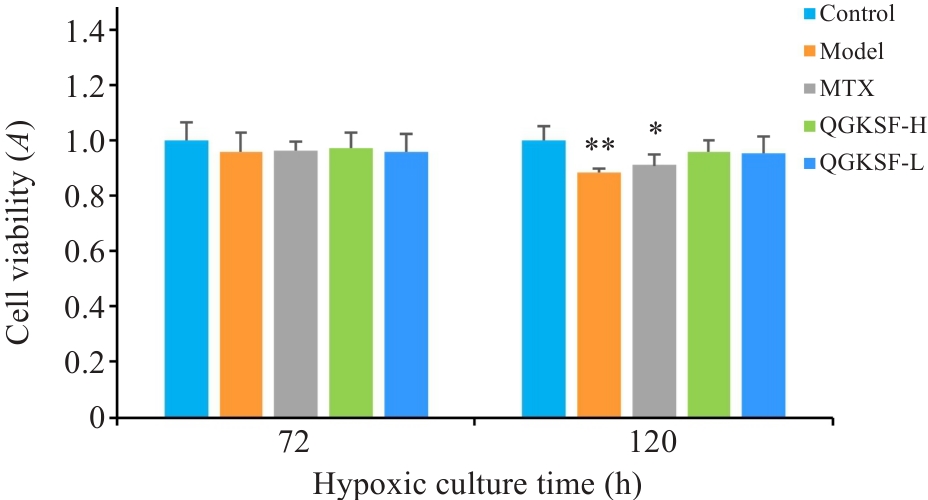
Fig.1 Effect of rat sera medicated with Qianggu Kangshu Formula (QGKSF) and methotrexate (MTX) on survival rate of RAW264.7 cells cultured in hypoxia for 72 h and 120 h (Mean±SD, n=5). *P<0.05, **P<0.01 vs Control group.
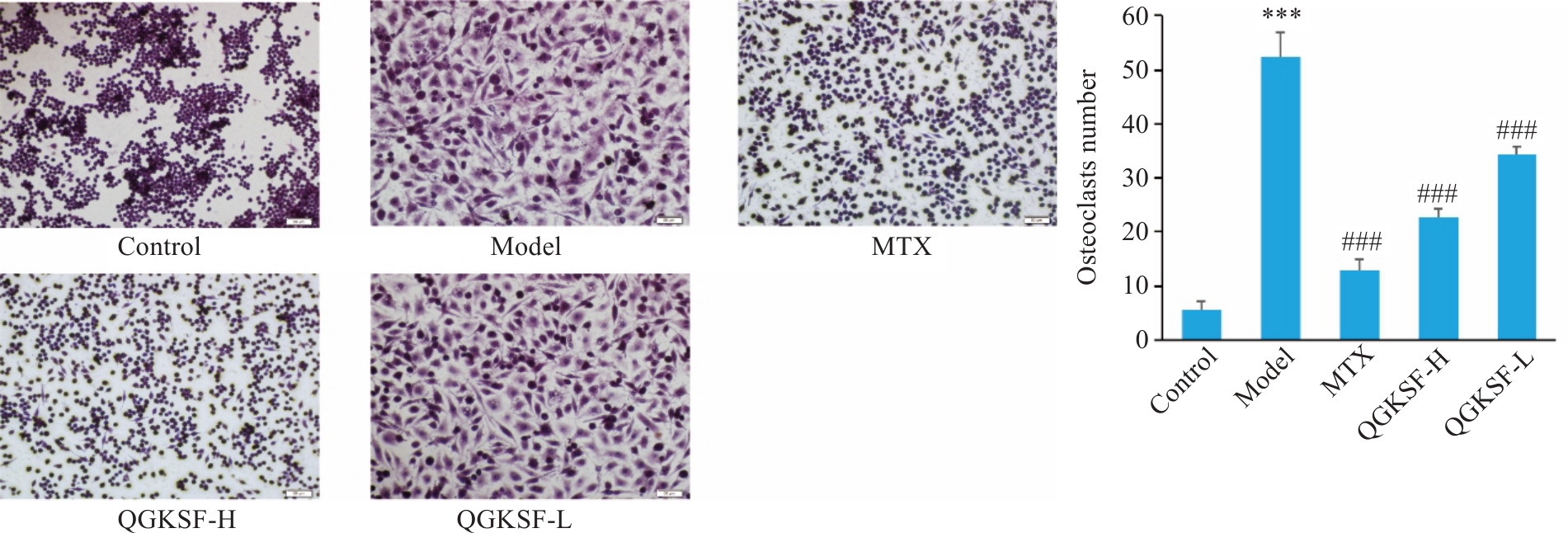
Fig.2 TRAP staining showing RAW264.7 cell differentiation into osteoclasts in different groups (Original magnification: ×200). ***P<0.001 vs Control group; ###P<0.001 vs Model group (Mean±SD, n=3).

Fig.3 Effect of QGKSF-medicated serum on actin ring formation in RAW264.7 cells induced by hypoxia +RANKL (×200). ***P<0.001 vs Control group; ###P<0.001 vs Model group.
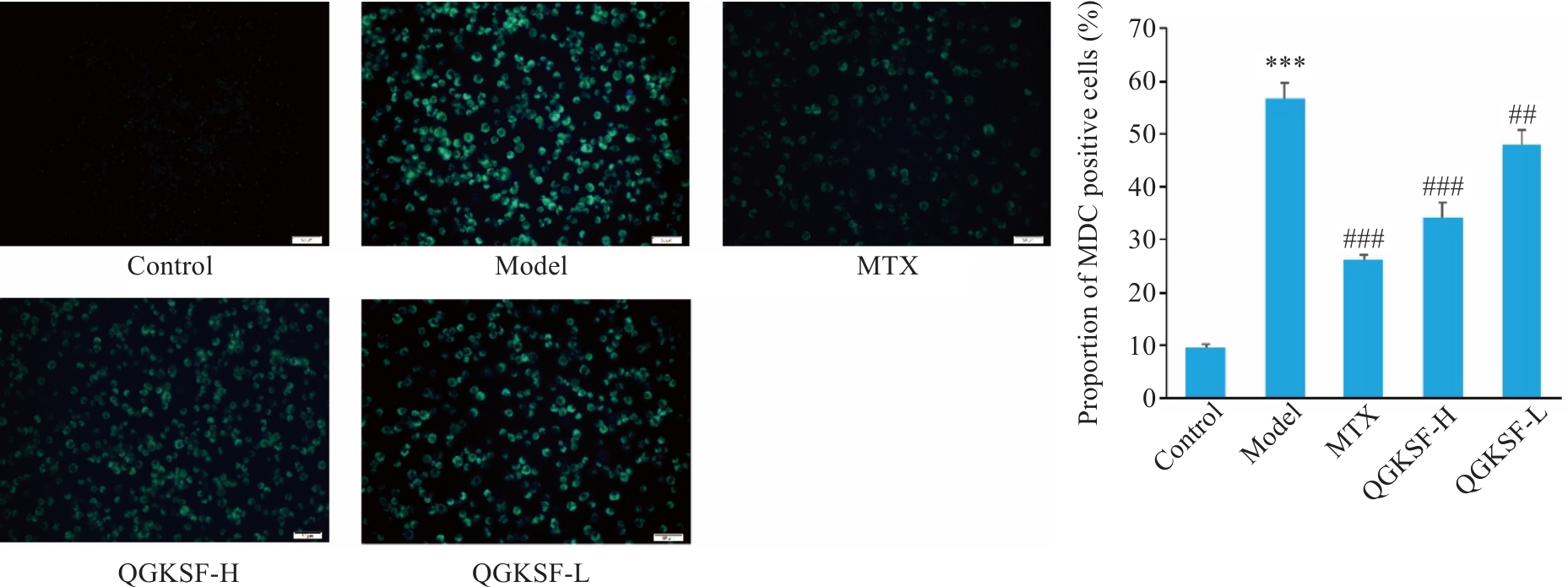
Fig.4 Effect of QGKSF-medicated sera on autophagy in hypoxia- and RANKL-induced RAW264.7 cells (×200). ***P<0.001 vs Control group; ##P<0.01, ###P<0.001 vs Model group.
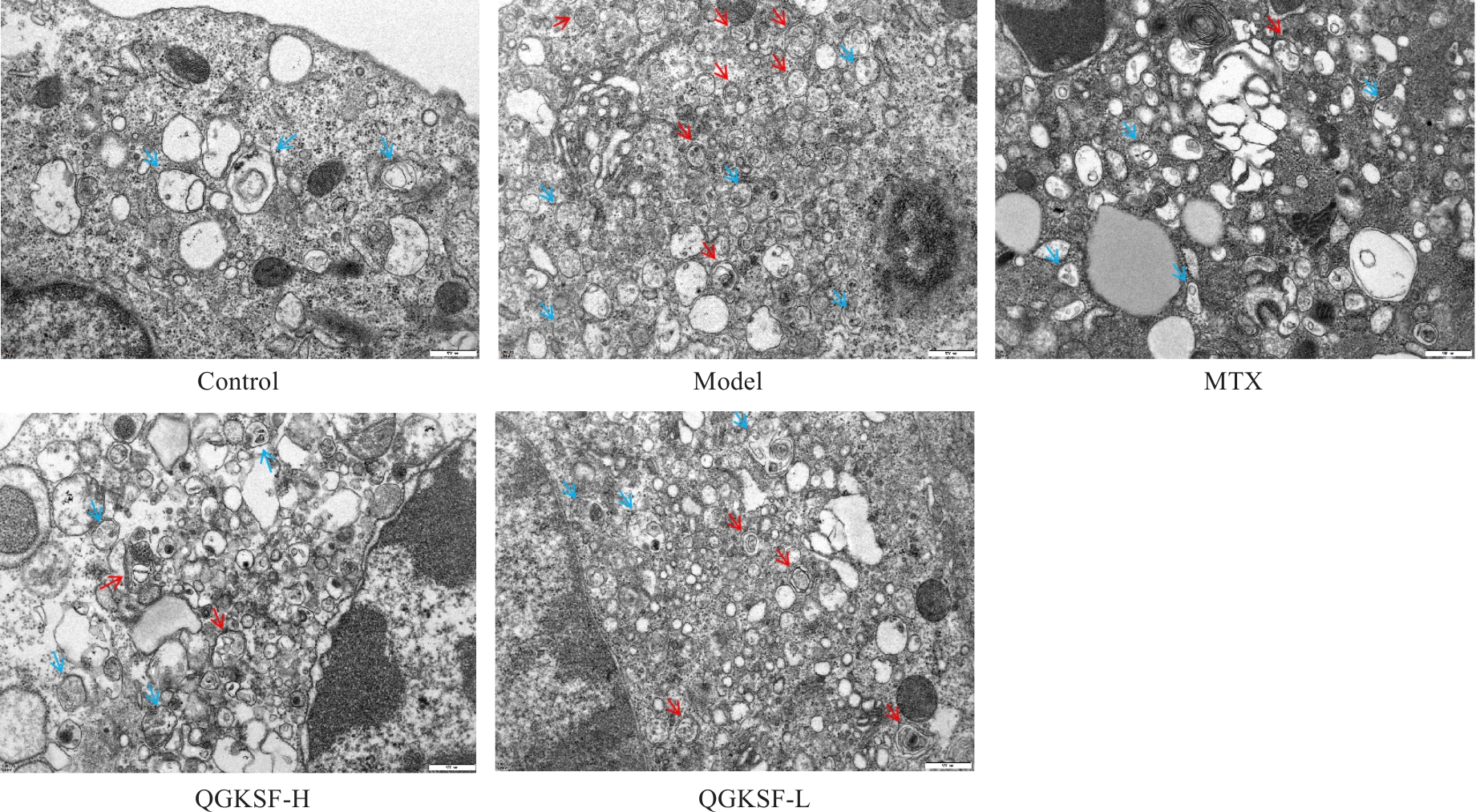
Fig.5 Observation of autophagosomes (red arrows) and autolysosomes (blue arrows) in RAW264.7 cells in different groups under transmission electron microscopy (×10 000).
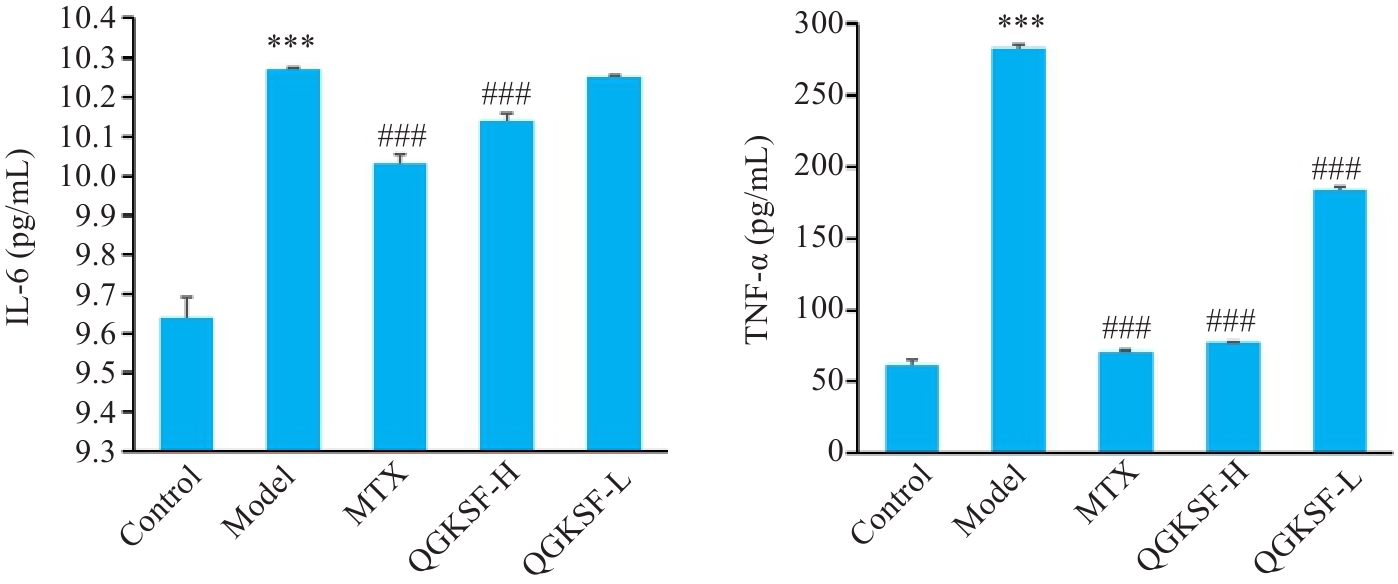
Fig.6 Levels of inflammatory cytokines IL-6 and TNF‑α in RAW264.7 cell cultures determined with ELISA. ***P<0.001 vs Control group; ###P<0.001 vs Model group.
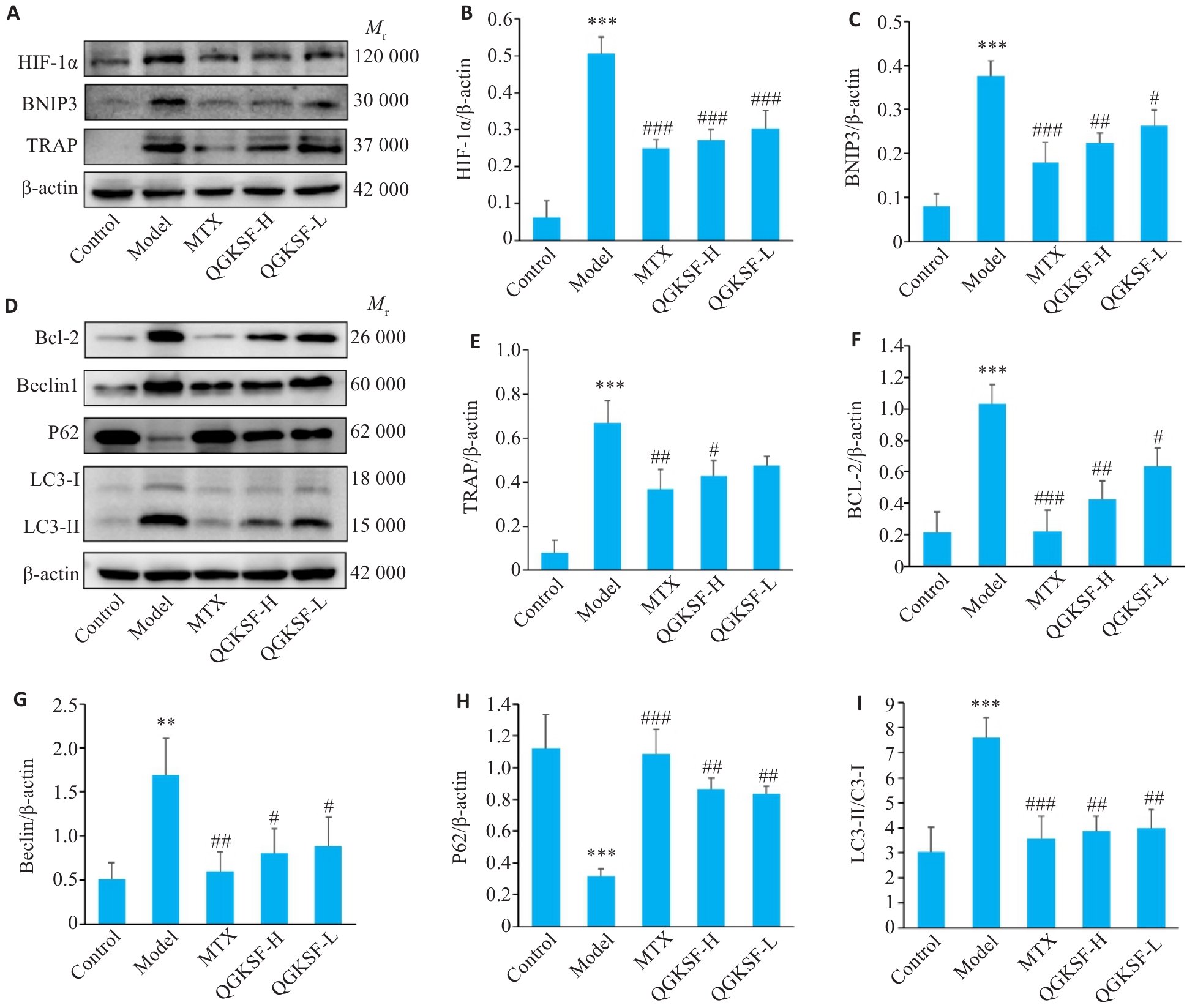
Fig.7 Effects of QGKSF-medicated sera on protein expressions of osteoclast markers, autophagy markers and the HIF-1α/BNIP3 signaling pathway in RAW264.7 cells. A: Protein expressions of osteoclast markers and the HIF-1α/BNIP3 signaling pathway. B: HIF-1α expression level. C: BNIP3 expression level. D: Protein expressions of autophagy markers. E: TRAP expression level. F: Bcl-2 expression level. G: Beclin1 expression level. H: P62 expression level. I: LC3 expression level. Data are presented as Mean±SD (n=3). **P<0.01, ***P<0.001 vs Control group; #P<0.05, ##P<0.01, ###P<0.001 vs Model group.
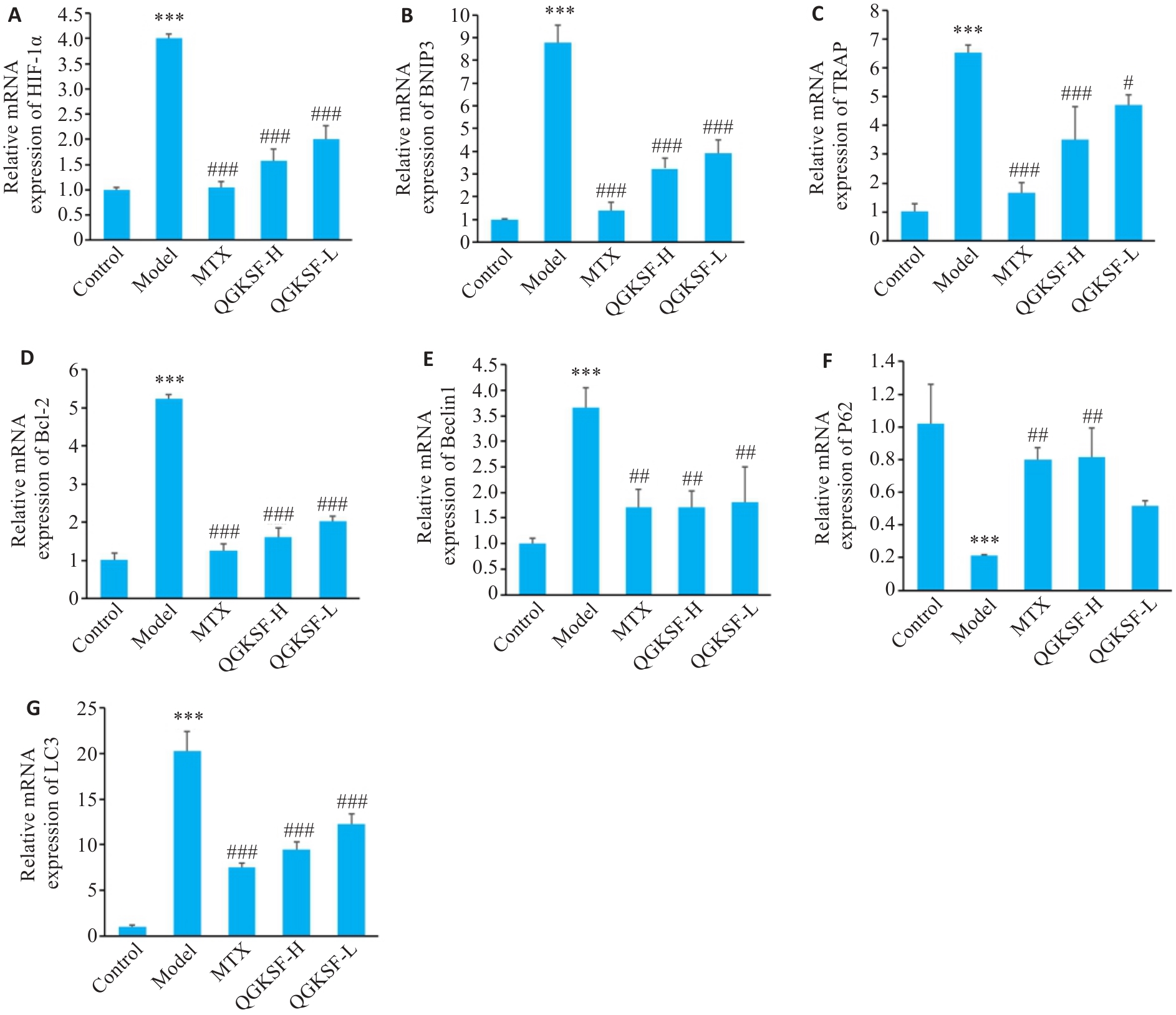
Fig.8 Effects of QGKSF-medicated sera on mRNA expressions of osteoclast markers, autophagy markers and the HIF-1α/BNIP3 signaling pathway in RAW264.7 cells. A: HIF-1α mRNA expression level. B: BNIP3 mRNA expression level. C: TRAP mRNA expression level. D: Bcl-2 mRNA expression level. E: Beclin1 mRNA expression level. F: P62 mRNA expression level. G: LC3 mRNA expression level. Data are presented as Mean±SD (n=3). ***P<0.001 vs Control group; #P<0.05, ##P<0.01, ###P<0.001 vs Model group.
| [1] | McInnes IB, Schett G. Pathogenetic insights from the treatment of rheumatoid arthritis[J]. Lancet, 2017, 389(10086): 2328-37. doi:10.1016/s0140-6736(17)31472-1 |
| [2] | Scherer HU, Häupl T, Burmester GR. The etiology of rheumatoid arthritis[J]. J Autoimmun, 2020, 110: 102400. doi:10.1016/j.jaut.2019.102400 |
| [3] | 黄凤玉, 陶雪莹, 祝盼盼, 等. 基于转录组学与网络药理学探索青蒿琥酯对实验性类风湿关节炎骨破坏的作用机制[J]. 中国中药杂志, 2023, 48(5): 1343-51. doi:10.19540/j.cnki.cjcmm.20221013.403 |
| [4] | 刘妍彤, 任 爽, 曹 奇, 等. 脾虚生湿病机观与自噬在RA发病过程中相关性探讨[J]. 时珍国医国药, 2022, 33(6): 1409-12. doi:10.3969/j.issn.1008-0805.2022.06.39 |
| [5] | 李福欣, 杜小正, 张星华, 等. HIF-1α调控糖酵解在RA炎症发病机制中的研究[J]. 中国骨质疏松杂志, 2023, 29(2): 226-31. doi:10.3969/j.issn.1006-7108.2023.02.014 |
| [6] | Schiraldi M, Raucci A, Muñoz LM, et al. HMGB1 promotes recruitment of inflammatory cells to damaged tissues by forming a complex with CXCL12 and signaling via CXCR4[J]. J Exp Med, 2012, 209(3): 551-63. doi:10.1084/jem.20111739 |
| [7] | 李 磊. 非甾体抗炎药治疗风湿性关节炎疗效及不良反应[J]. 临床合理用药杂志, 2019, 12(4): 88-9. |
| [8] | 万 昭. 强骨康疏方对RAW264.7细胞向OC分化的抑制作用及其机制初探[D]. 湖北: 湖北民族大学, 2019. |
| [9] | 田 乐, 朴松兰, 何艳新, 等. 红景天含药血清对肿瘤坏死因子α诱导的人类风湿关节炎成纤维样滑膜细胞增殖的影响[J]. 中药新药与临床药理, 2022, 33(3): 287-92. |
| [10] | 刘颖姝, 高明利. 益气养阴通络方经凋亡通路治疗类风湿关节炎的网络药 理学预测与验证[J]. 辽宁中医杂志, 2022, 49(6): 11-6. doi:10.13192/j.issn.1000-1719.2022.06.003 |
| [11] | 南奕阳. 基于TLR4/NF-κB通路探讨三百棒对CIA大鼠滑膜作用影响的机制 [D]. 湖北: 湖北民族大学, 2019. |
| [12] | 庞欣怡, 于 畅, 张力丹, 等. 中药及民族药药浴治疗类风湿性关节炎研 究进展[J]. 中药与临床, 2022,13(6): 92-5. |
| [13] | Jeon CH, Ahn JK, Chai JY, et al. Hypoxia appears at pre-arthritic stage and shows co-localization with early synovial inflammation in collagen induced arthritis[J]. Clin Exp Rheumatol, 2008, 26(4): 646-8. doi:10.1090/S0002-9947-03-03452-4 |
| [14] | Shi XL, Hu BB, Ren MM, et al. Hypoxia regulates the expression of OPG/RANKL mRNA in rat bone marrow mesenchymal stem cells[J]. Shanghai Kou Qiang Yi Xue, 2017, 26(3): 258-62. |
| [15] | 兰维娅, 唐 芳, 马武开, 等. HIF-1α在类风湿关节炎中的研究进展[J]. 中国老年学杂志, 2024, 44(9): 2265-9. |
| [16] | Jiang C, Shang J, Li Z, et al. Lanthanum chloride attenuates osteoclast formation and function via the downregulation of rankl-induced nf-κb and Nfatc1 activities[J]. J Cell Physiol, 2016, 231(1): 142-51. doi:10.1002/jcp.25065 |
| [17] | Kong L, Ma R, Cao Y, et al. Cell cytoskeleton and proliferation study for the RANKL-induced RAW264.7 differentiation[J]. J Cell Mol Med, 2021, 25(10): 4649-57. doi:10.1111/jcmm.16390 |
| [18] | 向 珊, 张宗星, 江 露, 等. 三百棒通过调控PI3K/Akt信号通路改善胶原 诱导性类风湿性关节炎大鼠的血管翳[J]. 南方医科大学学报, 2024, 44(8): 1582-8. doi:10.12122/j.issn.1673-4254.2024.08.17 |
| [19] | Okabe I, Kikuchi T, Mogi M, et al. IL-15 and RANKL play a synergistically important role in osteoclastogenesis[J]. J Cell Biochem, 2017, 118(4): 739-47. doi:10.1002/jcb.25726 |
| [20] | Deer E, Herrock O, Campbell N, et al. The role of immune cells and mediators in preeclampsia[J]. Nat Rev Nephrol, 2023, 19(4): 257-70. doi:10.1038/s41581-022-00670-0 |
| [21] | Zhao Y, Chen g, Zhang W, et al. Autophagy regulates hypoxia‑ induced osteoclastogenesis through the HIF-1alpha/BNIP3 signaling pathway[J]. J Cell Physiol, 2012,227(2): 639-48. doi:10.1002/jcp.22768 |
| [22] | Deng W, Feng XB, Li X, et al. Hypoxia-inducible factor 1 in autoimmune diseases[J]. Cell Immunol, 2016, 303: 7-15. doi:10.1016/j.cellimm.2016.04.001 |
| [23] | Quiñonez-Flores CM, González-Chávez SA, Pacheco-Tena C. Hypoxia and its implications in rheumatoid arthritis[J]. J Biomed Sci, 2016, 23(1): 62. doi:10.1186/s12929-016-0281-0 |
| [24] | Wang Y, Da GL, Li HB, et al. Avastin exhibits therapeutic effects on collagen-induced arthritis in rat model[J]. Inflammation, 2013, 36(6): 1460-7. doi:10.1007/s10753-013-9687-y |
| [25] | Kubasiak LA, Hernandez OM, Bishopric NH, et al. Hypoxia and acidosis activate cardiac myocyte death through the Bcl-2 family protein BNIP3[J]. Proc Natl Acad Sci USA, 2002, 99(20): 12825-30. doi:10.1073/pnas.202474099 |
| [26] | Regula KM, Ens K, Kirshenbaum LA. Inducible expression of BNIP3 provokes mitochondrial defects and hypoxia-mediated cell death of ventricular myocytes[J]. Circ Res, 2002, 91(3): 226-31. doi:10.1161/01.res.0000029232.42227.16 |
| [27] | Zhang H, Bosch-Marce M, Shimoda LA, et al. Mitochondrial autophagy is an HIF-1-dependent adaptive metabolic response to hypoxia[J]. J Biol Chem, 2008, 283(16): 10892-903. doi:10.1074/jbc.m800102200 |
| [28] | Lin NY, Beyer C, Gießl A, et al. Autophagy regulates TNF‑α-mediated joint destruction in experimental arthritis[J]. Ann Rheum Dis, 2013, 72(5): 761-8. doi:10.1136/annrheumdis-2012-201671 |
| [29] | Hong ZY, Wang H, Zhang TJ, et al. The HIF-1/BNIP3 pathway mediates mitophagy to inhibit the pyroptosis of fibroblast-like synoviocytes in rheumatoid arthritis[J]. Int Immunopharmacol, 2024, 127: 111378. doi:10.1016/j.intimp.2023.111378 |
| [30] | Deng R, Wang Y, Bu Y, et al. BNIP3 mediates the different adaptive responses of fibroblast-like synovial cells to hypoxia in patients with osteoarthritis and rheumatoid arthritis[J]. Mol Med, 2022, 28(1): 64. doi:10.1186/s10020-022-00490-9 |
| [1] | Xinheng WANG, Xiaohan SHAO, Tongtong LI, Lu ZHANG, Qinjun YANG, Weidong YE, Jiabing TONG, Zegeng LI, Xiangming FANG. Pingchuanning Formula suppresses airway inflammation in a rat model of asthmatic cold syndrome by regulating the HMGB1/Beclin-1 axis-mediated autophagy [J]. Journal of Southern Medical University, 2025, 45(6): 1153-1162. |
| [2] | Yanyan DONG, Kejing ZHANG, Jun CHU, Quangen CHU. Didang Decoction-medicated serum enhances autophagy in high glucose-induced rat glomerular endothelial cells via the PI3K/Akt/mTOR signaling pathway [J]. Journal of Southern Medical University, 2025, 45(3): 461-469. |
| [3] | Ming LIAO, Wenhua ZHONG, Ran ZHANG, Juan LIANG, Wentaorui XU, Wenjun WAN, Chao LI Shu WU. Protein C activator derived from snake venom protects human umbilical vein endothelial cells against hypoxia-reoxygenation injury by suppressing ROS via upregulating HIF-1α and BNIP3 [J]. Journal of Southern Medical University, 2025, 45(3): 614-621. |
| [4] | Kelei GUO, Yingli LI, Chenguang XUAN, Zijun HOU, Songshan YE, Linyun LI, Liping CHEN, Li HAN, Hua BIAN. Yiqi Yangyin Huazhuo Tongluo Formula alleviates diabetic podocyte injury by regulating miR-21a-5p/FoxO1/PINK1-mediated mitochondrial autophagy [J]. Journal of Southern Medical University, 2025, 45(1): 27-34. |
| [5] | Junping ZHAN, Shuo HUANG, Qingliang MENG, Wei FAN, Huimin GU, Jiakang CUI, Huilian WANG. Buyang Huanwu Decoction reduces mitochondrial autophagy in rheumatoid arthritis synovial fibroblasts in hypoxic culture by inhibiting the BNIP3-PI3K/Akt pathway [J]. Journal of Southern Medical University, 2025, 45(1): 35-42. |
| [6] | Zhiliang CHEN, Yonggang YANG, Xia HUANG, Yan CHENG, Yuan QU, Qiqi HENG, Yujia FU, Kewei LI, Ning GU. Differential expressions of exosomal miRNAs in patients with chronic heart failure and hyperuricemia: diagnostic values of miR-27a-5p and miR-139-3p [J]. Journal of Southern Medical University, 2025, 45(1): 43-51. |
| [7] | Yao CHENG, Yuanying WANG, Feiyang YAO, Pan HU, Mingxian CHEN, Ning WU. Baicalin suppresses type 2 dengue virus-induced autophagy of human umbilical vein endothelial cells by inhibiting the PI3K/AKT pathway [J]. Journal of Southern Medical University, 2024, 44(7): 1272-1283. |
| [8] | Yeming ZHANG, Yuanxiang ZHANG, Xuebin SHEN, Guodong WANG, Lei ZHU. MiRNA-103-3p promotes neural cell autophagy by activating Wnt/β-catenin signaling via targeting rab10 in a rat model of depression [J]. Journal of Southern Medical University, 2024, 44(7): 1315-1326. |
| [9] | Qianyi CHEN, Shuhan SHANG, Huan LU, Sisi LI, Zhimian SUN, Xirui FAN, Zhilin QI. Calenduloside E inhibits hepatocellular carcinoma cell proliferation and migration by down-regulating GPX4 and SLC7A11 expression through the autophagy pathway [J]. Journal of Southern Medical University, 2024, 44(7): 1327-1335. |
| [10] | ZHOU Fengmin, GUO Yanju, CHEN Ning. Exercise promotes irisin expression to ameliorate renal injury in type 2 diabetic rats [J]. Journal of Southern Medical University, 2024, 44(4): 675-681. |
| [11] | CHEN Junjie, HUANG Chuanbing, LI Ming. Jianpi Zishen granule inhibits podocyte autophagy in systemic lupus erythematosus: a network pharmacology and clinical study [J]. Journal of Southern Medical University, 2024, 44(3): 465-473. |
| [12] | XIAO Hongmin, HAN Baosong, GUO Jiacheng, WU Chao, WU Jingyi. HTD4010 attenuates myocardial injury in mice with septic cardiomyopathy by promoting autophagy via the AMPK/mTOR signaling pathway [J]. Journal of Southern Medical University, 2024, 44(3): 507-514. |
| [13] | Yunfei LI, Lijun PANG, Longwu SHU, Ming LI, Chuanbing HUANG. Qihuang Jianpi Zishen Granules improves thrombocytopenia in mice with systemic lupus erythematosus by suppressing platelet autophagy via the Ca2+/CaMKK2/AMPK/mTOR signaling pathway [J]. Journal of Southern Medical University, 2024, 44(12): 2327-2334. |
| [14] | Chengcheng JIANG, Yangyang LI, Kexin DUAN, Tingting ZHAN, Zilong CHEN, Yongxue WANG, Rui ZHAO, Caiyun MA, Yu GUO, Changqing LIU. Parkin deletion affects PINK1/Parkin-mediated mitochondrial autophagy to exacerbate neuroinflammation and accelerate progression of Parkinson's disease in mice [J]. Journal of Southern Medical University, 2024, 44(12): 2359-2366. |
| [15] | Huan LI, Zixin QIU, Wenjie XU, Xue CHEN, Diandian WEI, Yun WANG. Luteolin inhibits proliferation of lung cancer A549 cells by increasing ROS production and inhibiting the AKT/mTOR signaling pathway and HO-1 expression [J]. Journal of Southern Medical University, 2024, 44(12): 2367-2374. |
| Viewed | ||||||
|
Full text |
|
|||||
|
Abstract |
|
|||||